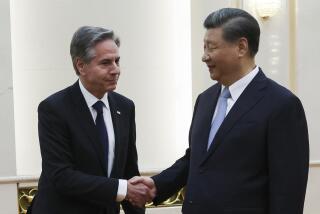Pitfalls on Path of Continued Growth
- Share via
Between 1980 and 2002, China’s annual economic growth was a stunning 8.6%. Despite some fuzzy statistics, this remarkable record overshadows Japan’s economic “miracle” of the 1970s and 1980s with its annual growth of 5%. If China were to sustain an 8% growth rate, its gross domestic product would be only modestly below that of the United States by 2025, although its per capita output would be less than 15% of that of the U.S.
But China’s growth is not destined. There are potential fault lines that could severely hinder or even reverse it, with dramatic consequences for Chinese society, government and party structure. Among them are:
* Unemployment, poverty and social unrest. Reported plus disguised unemployment in China amounts to more than 20% of the labor force, or approximately 170 million workers. Factors contributing to rising joblessness are the population increases of the 1980s, privatization, the downsizing of inefficient state-owned enterprises and the further opening of its markets to imports, a requirement for membership in the World Trade Organization. Meanwhile, the potential for social unrest hangs over the economy. Income inequality between rural and urban areas continues to feed rural-to-urban migration and rising urban unemployment. Should joblessness and social unrest worsen, growth in the next 10 years could annually decline by as much as 0.8%.
* Corruption. It’s difficult to estimate how the country’s pervasive corruption may crimp its economic growth. Corruption hurts economic activity, among other ways, by distorting the allocations of resources through such practices as nepotism, favoritism in the awarding of contracts and the failure to enforce contracts and property rights. Were corrupt practices to worsen, China’s annual growth rate could diminish by about 0.5%.
* HIV/AIDS and epidemic disease. According to various estimates, between 600,000 and 1.3 million Chinese are HIV-infected or have AIDS. Worse, the disease is expected to grow annually at a rate between 20% and 30%. Clearly, costs of treatment and declines in productivity and output will begin to seriously affect economic growth. Less pessimistic scenarios place annual deaths from HIV/AIDS at between 1.7 million and 2.7 million people in the second decade of this century, cumulating by 2020 in more than 20 million. The associated annual reductions in China’s GDP growth could be between 1.8% and 2.2%. The possible spread of severe acute respiratory syndrome, although less disabling than AIDS, could further impede growth.
* Water resources and pollution. While more than one-third of China’s population lives in the northern part of the country, and the region accounts for roughly one-third of its GDP, only 7.5% of its naturally available water supplies are in the north. Industry discharges and other sources of pollution aggravate the shortage of water. Typically, south China enjoys an abundance of water supplies, but the country’s distribution system is seriously flawed. Whether China’s policymakers push for less-efficient, capital-intensive water-transfer projects or opt for more-efficient recycling and conservation in the north, China’s unreliable water supplies will significantly affect its growth. Failure to solve its water shortages could reduce China’s annual GDP growth by 1.5% to 1.9%.
* Energy consumption and prices. In the early 1990s, China was a net exporter of oil; today, it imports nearly half its oil and nearly one-fifth of its natural gas. But the major risk for China’s growth is less related to its increasing reliance on oil imports than to crude and gas prices. If prices surge and remain high for a decade, China’s annual growth could fall by between 1.2% and 1.4%.
* Fragility of the financial system and state-owned enterprises. The balance sheets of China’s four major state banks are riddled with nonperforming loans. The bulk were made to money-losing state-owned enterprises. Estimates of their total value vary enormously, but they may amount to more than 60% of China’s GDP, or $1.6 trillion. Should China experience a run on its banks, large-scale capital flight, a significant reduction in savings or a decline in capital formation, the ensuing financial crisis and credit squeeze could lower annual GDP growth by at least 0.5% to 1%.
* Possible shrinkage of foreign direct investment. In the last 15 years, foreign direct investment has steadily risen, reaching $50 billion in 2002 and significantly boosting China’s economic growth. Yet, many internal and external developments could slow it. For example, the heretofore smooth leadership succession could encounter turbulence, the SARS epidemic could alter investors’ expectations or improving investment climates in Eastern Europe, Russia, Indonesia and India could compete with China for foreign capital. A recent Rand Corp. study estimated that a sustained reduction of $10 billion a year in foreign direct investment might cut China’s annual GDP growth by between 0.6% and 1.6%.
* Taiwan and other potential conflicts. Though the status quo in relations between China and Taiwan broadly benefits the two countries and the United States, tensions might escalate into a conflict, with consequences that could lower China’s annual growth between 1% and 1.3%.
Were all these fault lines to fail simultaneously, China’s annual growth would be reduced between 7.4% and 10.7%, resulting in negative numbers for its economic performance as a whole. True, the probability of this happening is extremely low, but the chance that no fault line will fail is low as well. More probable, several factors might cluster because of their interdependence. For example, an internal financial crisis would be very likely to hurt foreign direct investment, worsen unemployment and lead to more corruption.
Mindful of the many obstacles that could disrupt economic growth, China’s new leadership will probably seek to avoid external distractions and especially to maintain equable relations with the United States.
More to Read
Inside the business of entertainment
The Wide Shot brings you news, analysis and insights on everything from streaming wars to production — and what it all means for the future.
You may occasionally receive promotional content from the Los Angeles Times.










